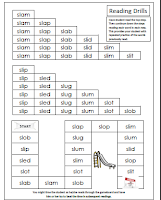Games/Interactives
Printables

Stairs games have always been a winner in our phonics activity bag (and great for math too). You can write phonograms, math facts, letters, words, etc on the stairs and student must read the item (or do the math fact) to progress up the stairs. I sometimes place a treat at the top of the stairs (candy, sticker, picture card, etc.)




- Consonant Blend Worksheets - Enchanted Learning
Sample 2 Day Lesson Plan for R Blends
Day 1:
- Go over Review flashcard deck
- Introduce new blends:
- Show flashcards and give sound of each new blend; (you might glue a picture of a word that starts with the blend on the back--see my matching cards) have student repeat sounds after you.
- Do online interactive: Word Warehouse- R Blends
- Play Stair Step Game
- Have student read words and sentences with the R Blends (do reading drills, stair step game with words instead of the blends, tic tac toe, bingo, etc).
- Dictate words (or show picture cards) of words that start with the blends, have student write the blend that makes the sound found in the word (if you feel student can write the actual words, you can alternatively have them write the words)
- Wrap up by reviewing R blend flashcards having student reproduce the sound of each blend and/or make a visual for student's phonics notebook.
Day 2:
- Go over Review flashcard deck
- Practice R Blends
- Go over R blends flashcards (or use student's visual in notebook, if you made one the previous lesson, to review the sounds)
- Practice reading words and sentences with the R blends (game format is preferred, if not, just read lists and sentences)
- Clue game - give clues for words that start with the R blends and have student write the blend or word to match.
- Hop a Blend - my daughter likes this game. I call out words that start with the blends, she hops near the flashcard with that blend (or you could take it outside and draw the blends with chalk in circles or squares).
- Wrap up by reviewing R blend flashcards.
Our phonics notebook entries for R blends:

















































